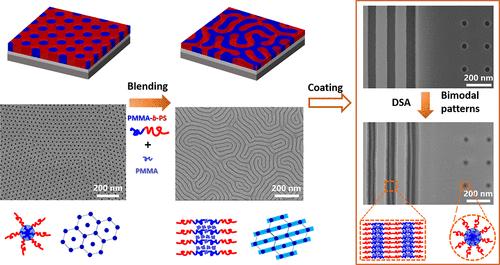Tailoring the Morphology Transformation and Simultaneous Generation of Bimodal Patterns through Directed Self-Assembly of Binary Cylindrical Block Copolymer/Homopolymer Blends
IF 5.2
1区 化学
Q1 POLYMER SCIENCE
引用次数: 0
Abstract
Lithography with directed self-assembly (DSA) has demonstrated significant potential in fabricating integrated circuits, particularly in logic and memory chips with periodic patterns. However, it is challenging to achieve asymmetrical line patterns with block copolymers (BCPs) that meet the manufacturing requirements of integrated circuits. We propose a binary cylindrical BCP/homopolymer blending strategy to generate asymmetric multiple line patterns. By carefully tailoring the blending rates of homopolymer poly(methyl methacrylate) (hPMMA) with different molecular weights in cylindrical polystyrene-b-poly(methyl methacrylate), we manipulate the morphology transformation, period, and PMMA duty cycle (space width relative to the pitch) of BCP/hPMMA self-assembly. Specifically, we employ a BCP/hPMMA blend to fine-tune the process window of asymmetric multiple line patterns with the aid of PS-affined topographical templates. This approach highlights the superiority of line pattern quality in the blends compared to the symmetric lamellar BCP. Moreover, the simultaneous generation of bimodal line and hole patterns was achieved through a one-step DSA process with one BCP/hPMMA blend. Furthermore, self-consistent field theory simulation was employed to explore the self-assembly of BCP/homopolymer blend in confined guiding templates, and the results were in good consistency with the experimental results. This strategy provides an essential technological platform for the fabrication of asymmetrical line and hole patterns with various resolutions and complex metal layers.

通过二元圆柱形嵌段共聚物/均聚物定向自组装裁剪形态转换和双峰模式同时生成
光刻定向自组装技术(DSA)在制造集成电路,特别是具有周期性图案的逻辑和存储芯片方面显示出巨大的潜力。然而,用嵌段共聚物(bcp)实现满足集成电路制造要求的不对称线条图案是具有挑战性的。我们提出了一种二元圆柱形BCP/均聚物共混策略来生成不对称的多线图案。通过在圆柱形聚苯乙烯-b-聚(甲基丙烯酸甲酯)中精心调整不同分子量的均聚聚合物聚(甲基丙烯酸甲酯)(hPMMA)的共混率,我们操纵了BCP/hPMMA自组装的形态转变、周期和PMMA占空比(相对于螺距的空间宽度)。具体来说,我们采用BCP/hPMMA混合,借助ps -仿射地形模板微调非对称多线图案的处理窗口。与对称的层状BCP相比,这种方法突出了共混物中线条图案质量的优越性。此外,通过一个BCP/hPMMA共混物的一步DSA工艺,可以同时生成双峰线和孔图案。利用自洽场理论模拟研究了BCP/均聚物在受限导向模板中的自组装过程,结果与实验结果吻合较好。该策略为各种分辨率和复杂金属层的非对称线和孔图案的制造提供了重要的技术平台。
本文章由计算机程序翻译,如有差异,请以英文原文为准。
求助全文
约1分钟内获得全文
求助全文
来源期刊

Macromolecules
工程技术-高分子科学
CiteScore
9.30
自引率
16.40%
发文量
942
审稿时长
2 months
期刊介绍:
Macromolecules publishes original, fundamental, and impactful research on all aspects of polymer science. Topics of interest include synthesis (e.g., controlled polymerizations, polymerization catalysis, post polymerization modification, new monomer structures and polymer architectures, and polymerization mechanisms/kinetics analysis); phase behavior, thermodynamics, dynamic, and ordering/disordering phenomena (e.g., self-assembly, gelation, crystallization, solution/melt/solid-state characteristics); structure and properties (e.g., mechanical and rheological properties, surface/interfacial characteristics, electronic and transport properties); new state of the art characterization (e.g., spectroscopy, scattering, microscopy, rheology), simulation (e.g., Monte Carlo, molecular dynamics, multi-scale/coarse-grained modeling), and theoretical methods. Renewable/sustainable polymers, polymer networks, responsive polymers, electro-, magneto- and opto-active macromolecules, inorganic polymers, charge-transporting polymers (ion-containing, semiconducting, and conducting), nanostructured polymers, and polymer composites are also of interest. Typical papers published in Macromolecules showcase important and innovative concepts, experimental methods/observations, and theoretical/computational approaches that demonstrate a fundamental advance in the understanding of polymers.
 求助内容:
求助内容: 应助结果提醒方式:
应助结果提醒方式:


